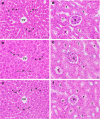Evaluation of the antimalarial activity and toxicity of Mahanil-Tang-Thong formulation and its plant ingredients
- PMID: 35219319
- PMCID: PMC8882293
- DOI: 10.1186/s12906-022-03531-2
Evaluation of the antimalarial activity and toxicity of Mahanil-Tang-Thong formulation and its plant ingredients
Abstract
Background: Novel potent antimalarial agents are urgently needed to overcome the problem of drug-resistant malaria. Herbal treatments are of interest because plants are the source of many pharmaceutical compounds. The Mahanil-Tang-Thong formulation is a Thai herbal formulation in the national list of essential medicines and is used for the treatment of fever. Therefore, this study aimed to evaluate the antimalarial activity of medicinal plants in the Mahanil-Tang-Thong formulation.
Methods: Nine medicinal plant ingredients of the Mahanil-Tang-Thong formulation were used in this study. Aqueous and ethanolic extracts of all the plants were analyzed for their phytochemical constituents. All the extracts were used to investigate the in vitro antimalarial activity against Plasmodium falciparum K1 (chloroquine-resistant strain) by using the lactate dehydrogenase (pLDH) method and cytotoxicity in Vero cells by using the 3-(4,5-dimethylthiazol2-yl)-2,5-diphenyltetrazolium bromide (MTT) assay. Additionally, an extract with potent in vitro antimalarial activity and no toxicity was selected to determine the in vivo antimalarial activity with Peters' 4-day suppressive test against the Plasmodium berghei ANKA strain. Acute toxicity was evaluated in mice for 14 days after the administration of a single oral dose of 2000 mg/kg.
Results: This study revealed that ethanolic extracts of Sapindus rarak DC., Tectona grandis L.f., Myristica fragrans Houtt. and Dracaena loureiri Gagnep. exhibited potent antimalarial activity, with half-maximal inhibitory concentration (IC50) values of 2.46, 3.21, 8.87 and 10.47 μg/ml, respectively, while the ethanolic of the formulation exhibited moderate activity with an IC50 value of 37.63 μg/ml and its aqueous extract had no activity (IC50 = 100.49 μg/ml). According to the in vitro study, the ethanolic wood extract of M. fragrans was selected for further investigation in an in vivo mouse model. M. fragrans extract at doses of 200, 400, and 600 mg/kg body weight produced a dose-dependent reduction in parasitemia by 8.59, 31.00, and 52.58%, respectively. No toxic effects were observed at a single oral dose of 2000 mg/kg body weight.
Conclusion: This study demonstrates that M. fragrans is a potential candidate for the development of antimalarial agents.
Keywords: Antimalarial activity; Mahanil-Tang-Thong formulation; Malaria; Medicinal plants; Toxicity.
© 2022. The Author(s).
Conflict of interest statement
The authors declare that they have no competing interests regarding the publication of this paper.
Figures

References
-
- Roper C, Pearce R, Bredenkamp B, Gumede J, Drakeley C, Mosha F, et al. Antifolate antimalarial resistance in southeast Africa: a population-based analysis. Lancet (London, England) 2003;361(9364):1174–1181. - PubMed
-
- Nair S, Williams JT, Brockman A, Paiphun L, Mayxay M, Newton PN, et al. A selective sweep driven by pyrimethamine treatment in southeast asian malaria parasites. Mol Biol Evol. 2003;20(9):1526–1536. - PubMed
-
- Wellems TE, Plowe CV. Chloroquine-resistant malaria. J Infect Dis. 2001;184(6):770–776. - PubMed
MeSH terms
Substances
LinkOut - more resources
Full Text Sources

